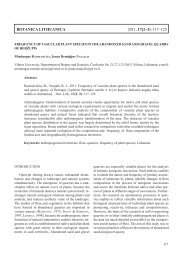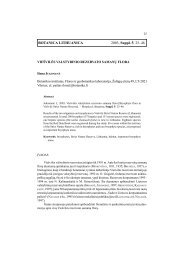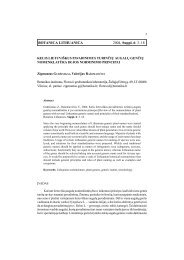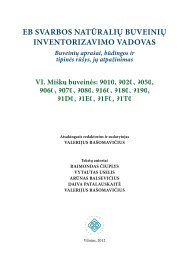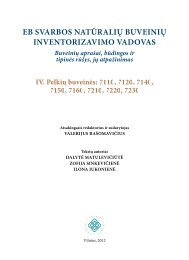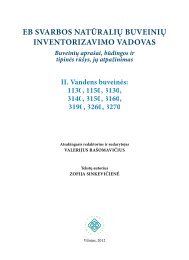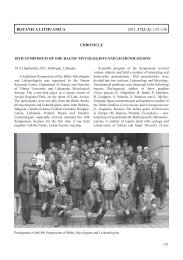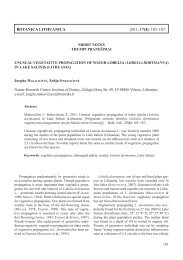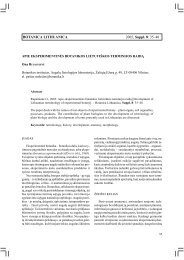FUNGI AND LICHENS IN THE BALTICS AND BEYOND XVIII ...
FUNGI AND LICHENS IN THE BALTICS AND BEYOND XVIII ...
FUNGI AND LICHENS IN THE BALTICS AND BEYOND XVIII ...
You also want an ePaper? Increase the reach of your titles
YUMPU automatically turns print PDFs into web optimized ePapers that Google loves.
<strong>FUNGI</strong> ASSOCIATED WITH SEED <strong>AND</strong> PLANT <strong>IN</strong>FECTION OF PEPPER<br />
R. RODEVA 1 , Z. STOYANOVA 1 , E. SURVILIENE 2 , P. CHAVDAROV 3<br />
1 Institute of Plant Physiology and Genetics of BAS, 1113 Sofia, Bulgaria<br />
2 Institute of Horticulture, Lithuanian Research Centre for Agriculture and Forestry, Kauno 30,<br />
Babtai LT-54333, Kaunas distr., Lithuania<br />
3 Institute for Plant Genetic Resources, Sadovo, Bulgaria<br />
E-mails: r.rodeva@abv.bg, zornica_st@abv.bg, e.surviliene@lsdi.lt,<br />
chavdarov_petar@abv.bg<br />
Plant diseases can be a limiting factor in pepper production in Bulgaria and Lithuania.<br />
Fungus related diseases are the most common. Plants may exhibit wilting, discoloration, poor<br />
growth, and spots. Plant problems are often associated with infected seeds. An investigation<br />
was undertaken to range over the most distributed fungi associated with seed and plant<br />
infection of pepper. Root, stem, leaf, fruit and seed samples were collected from diseased<br />
pepper plants. Seeds or pieces of damaged tissue were surface sterilized and transferred on<br />
potato dextrose agar medium. Fungal pathogens were isolated, identified and characterized<br />
mainly at species level. Alternaria alternata, Alternaria solani, Fusarium oxysporum f. sp.<br />
capsici, Verticillium dahliae, Verticillium albo-atrum, Colletotrichum coccodes and<br />
Macrophomina phaseolina were found predominant in plants showing symptoms of wilting.<br />
The most frequently isolated fungi from aboveground plant parts were Botrytis cinerea,<br />
Alternaria alternata, A. solani, Colletotrichum acutatum, C. coccodes, C. gloeosporioides,<br />
Phomopsis capsici, Phoma sp., Fusarium solani. Fungal species Phytophthora capsici and<br />
Leveillula taurica were found only occasionally. Microbiological analysis on the potato<br />
dextrose agar medium of 16 varieties of sweet pepper seeds showed fungal infection up to<br />
5.63% and bacterial up to 16.88%. The dominant species and isolates of fungi determined by<br />
their morphological characteristics were Acremonium sp., Alternaria radicina, A. alternata, A.<br />
solani, Aspergillus sp., Botrytis cinerea, Cladosporium sp., Cladosporium cladosporioides, C.<br />
herbarum, C. sphaerospermum, Cercospora kikuchii, Colletotrichum dematium, Mortierella<br />
sp., Mortierella hyaline, Mucor sp., Penicillium sp., Rhizoctonia solani, Thielaviopsis<br />
basicola, Torula herbarum, Verticillium sp. and Mycelia sterilia. Adequate knowledge<br />
concerning the pathogens is essential for appropriate pest management.<br />
PATHOGENIC MICROBIOTA OF TREE LEAVES <strong>IN</strong> URBAN GREENERY OF<br />
M<strong>IN</strong>SK<br />
A. TELESH<br />
Department of Forest Protection and Wood Science, Belarusian State Technological<br />
University, Sverdlova Str. 13a, 220006 Minsk, Belarus<br />
E-mail: oxygene2009@tut.by<br />
Tillet (Tilia cordata), horse chestnut (Aesculus hippocastanum) and Norway maple are<br />
the predominating species which are used in green areas in transport and recreation areas of<br />
Minsk. Their frequency is 24.4%, 20.9% and 16.9% respectively. In the city conditions fungal<br />
diseases of leaves of these species such as blotch or powdery mildew are widespread. The<br />
distribution of leaf blotch of horse chestnuts reaches 50.0%, 18.1% of Norway maples and<br />
35.1% of tillets. Following species of disease agents of leaves are the most widespread and<br />
harmful: brown blotch (Phillosticta sphaeropsoidea (Ellis et Everh.) Petrak), yellow blotch<br />
(Phillosticta castaneae Ell. et Ev.), brown blotch (Cylindrosporium castanicola (Desm.)



